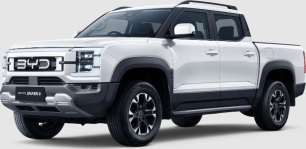This car is built on a dedicated electric architecture which theoretically gives it many benefits as there’s no space needed for a combustion engine, nor its transmission or driveline components.
While the Ariya benefits from this by pushing the wheels to the extremities, it underwhelms in others. More on this in a bit.
As standard the driver’s seat is mounted very high. I’m 182cm tall and in the seat's lowest position I was only a few centimetres off my hair tickling the roofliner. While this is nice from a forward visibility standpoint, I instinctively want to sit lower in the cabin.
Despite this, the front seats are deliciously comfortable. They offer plenty of electric adjustability, allowing you to find your desired seating position. Depending on the trim they’re heated and ventilated, which is a treat in fickle Melbourne weather.
As noted before, the steering wheel features physical buttons, which is a major plus. They’re clearly labelled and are easy to understand.
Ahead of the driver the digital instrument cluster is classic Nissan. There are a range of informative pages to cycle through, as well as two layouts to choose from. All of them look high-res.
Moving across, the touchscreen multimedia system is also a classic Nissan unit. Almost every Nissan model has a variation of this touchscreen now, which kind of makes the Ariya feel less special.
Thankfully however, the user interface is clear and easy to understand. It’s hard to get lost and even if you do, there are shortcut buttons on the side of the screen.
As standard there’s wireless Apple CarPlay, which is great if you have an iPhone and almost expected nowadays, however Android Auto is only offered in wired form only. This is disappointing from a high-tech flagship.
I appreciate there are haptic buttons for the climate control under the touchscreen. It’s much better than having these functions built into the touchscreen. However, the seat heating/ventilation and the steering wheel heating is in the touchscreen, but you can program it to an automatic mode so it’ll turn on and off with the climate control.
The haptic buttons extend onto the centre console which electrically slides in the Advance+ and Evolve. These ones are for the drive mode and ePedal selection.
Speaking of the centre console, it’s a big bulky unit but it barely offers any storage. Under the centre console lid there’s a wireless charger and a miniscule amount of storage. There’s also a tiny phone-sized slot at the front of the centre console, plus a 12V socket and some USB ports.
It’s disappointing Nissan hasn’t taken better advantage of the flat floor accommodated by the dedicated electric architecture. There’s open space between the driver and passenger, which makes it feel like you’re in dedicated recliners.
As a result of the paltry centre console storage, there are two gloveboxes. One on the passenger side and another in the centre. Both look like they’re sizeable, but that’s just the lid as the actual storage space is a fraction of this.
Moving to the second row I have a decent amount of legroom behind my own driving position. Toe room is negligible however and headroom suffers from the panoramic glass sunroof.
Despite this the second-row bench is still comfortable. It’s laid back, though there’s not much lateral support. This means in the bends you’ll be thrown into the door or into the centre of the car.
There continues to be a flat floor in the second row, plus a minimal hump in the rear bench means you could technically go three-up if you wanted. The limitation at this point is shoulder space.
In terms of amenities there are centre console-mounted air vents, USB-C ports, heated outboard seats (depending on the trim) and a fold-down armrest with cupholders. It’s fairly standard.
From the Advance trim and up there’s a standard hands-free power tailgate. This is handy if you’ve got your hands full.
For the boot space itself, it’s fine but not standout. Two-wheel-drive variants are notably better with 466L of boot space with the rear seats upright. The Evolve e-4orce only has 408L due to the rear electric motor.
As expected there’s no spare tyre at all across the line-up. Instead there’s a tyre repair kit under the boot floor.
No Ariya trim has a front boot.






